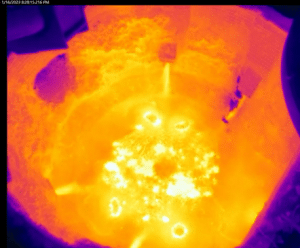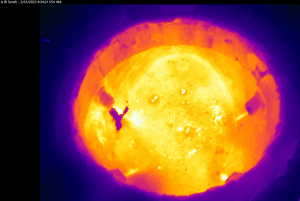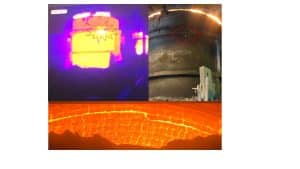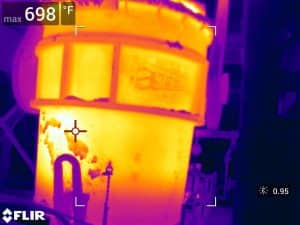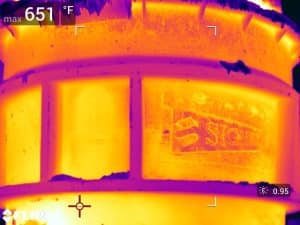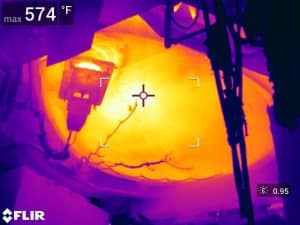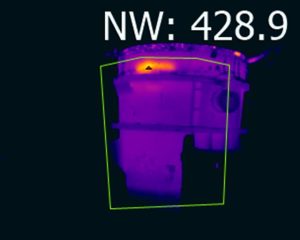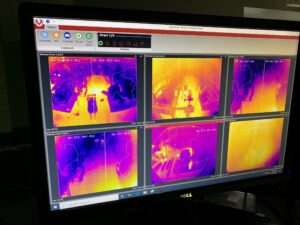Thermal Monitoring for Steel Process Automation and Optimization
Here are some frequently asked questions about how thermal monitoring can automate and optimize processes in the steel industry.
Which thermal cameras are right for this type of application?
What type of enclosure do you use for the Steel Mill Refractory Monitoring application?
How does alarming integrate into other systems?
Common applications: AOD, BOF, EAF, LMF, Refractory-Lined Ladles, Substation Assets, Torpedo Cars, and Water Wall Leak Detection
➡️ How does the alarming feature integrate into other systems?
When a thermal camera detects a significant temperature increase or abnormal heat pattern, it can trigger an alert, notifying operators or automatically shutting down a specific operation. ViperVision software supports communication standards for connection to the plant control system including OPC, Modbus, Allen-Bradley, or Siemens systems, as well as physical I/Os such as relays and analog outputs. It can send a discrete signal into your system through external I/O devices or the camera’s built-in I/O. This integration enables rapid response, minimizing the time between detection and remedial actions.
➡️ Will the system still work in highly contaminated areas?
Advanced thermal cameras employ algorithms that can mitigate environmental challenges, providing reliable fire detection even in adverse conditions. The thermal cameras we use are designed for industrial settings and have an IP66 rating. We often install these cameras in our ViperVenom camera enclosures which provide additional environmental protection. Options such as a front air knife or air intensifier are added for extremely dusty environments in order to keep the front window clean and free of contamination. And, regular maintenance and calibration of the cameras are also essential to ensure accurate readings.
➡️ Which thermal cameras are right for this type of application?
The main factors are temperature and optics. The upper measurement limit of the FLIR A50/A70 is 1000°C (1832°F) while it’s 2000°C (3623°F) for the FLIR A400/A700. As for optics, a camera with a wide angle can help minimize the number of cameras needed. But, if you need to measure a very small spot size, high resolution is key. Viper engineers have extensive experience and training to make the best recommendations. FLIR thermal cameras are designed for industrial settings and have an IP66 rating. We often install these cameras in our ViperVenom camera enclosures which provide additional environmental protection.
➡️ How is ViperVision software licensed?
We offer a perpetual license or annual renewal, as well as the option to incorporate the entire system into a HaaS (Hardware as a Service) contract. Benefits of annual renewal and HaaS include software updates since the last renewal date. Review software packages here.
➡️ What type of enclosure do you use for the steel mill refractory monitoring application?
We install the thermal cameras in our ViperVenom camera enclosures which provide additional environmental protection. Options such as a front air knife or air intensifier are added for extremely dusty environments in order to keep the front window clean and free of contamination.
➡️ For communication from camera to PC with a distance of about 300 meters (984 feet), would you use Ethernet Cable or Fiber Optic?
Ethernet cable is suitable for distances up to 300 feet (91 meters), while fiber optic is employed for 300 meters or more – depending on site-specific information (i.e. multimode or single mode).
Overall, thermal imaging camera monitoring systems offer significant advantages in automating and optimizing processes within the steel industry. From precise temperature control and predictive maintenance to energy efficiency and quality control, these systems help steel manufacturers enhance their operations, reduce costs, and improve overall productivity.
➡️ Can I get more details?
Yes, we have a recorded webinar! Here’s a link to watch the recording on YouTube. You can also download a datasheet, Steel Mill Refractory Monitoring Solutions. You can also contact us!
These advanced monitoring systems utilize infrared technology to capture and analyze thermal data, enabling numerous benefits in various stages of steel production. Here are a few key points:
- Temperature Monitoring: Thermal imaging cameras accurately measure temperatures in real-time, providing valuable data for monitoring and controlling critical steel processing stages such as heating, cooling, and annealing. This ensures optimal temperature conditions, reducing the risk of defects and ensuring product quality.
- Equipment Maintenance: By continuously monitoring the temperature of machinery and equipment, thermal imaging cameras can detect abnormal heat signatures that indicate potential malfunctions or impending failures. This enables proactive maintenance, preventing costly downtime and enhancing operational efficiency.
- Energy Efficiency: Thermal imaging cameras help identify areas of excessive heat loss or energy consumption in steel production facilities. By pinpointing insulation gaps, leakages, or inefficient heating processes, these systems enable companies to optimize energy usage, reduce waste, and minimize environmental impact.
- Safety Enhancement: We all know that steel production involves hazardous environments and extremely high-temperature operations. Thermal imaging cameras can detect hotspots, overheating equipment, or potential fire risks, allowing for swift action to prevent accidents and ensure the safety of personnel.
- Quality Control: By capturing detailed thermal images, these cameras aid in the identification of defects such as cracks, porosity, or uneven cooling in steel products. Automated thermal analysis algorithms can quickly analyze large datasets, ensuring consistent quality control and reducing the likelihood of faulty products reaching the market.
- Process Optimization: Continuous monitoring with thermal imaging cameras provides valuable data for process optimization in steel manufacturing. By analyzing temperature distribution and patterns, companies can optimize workflows and fine-tune parameters to maximize productivity and output.

